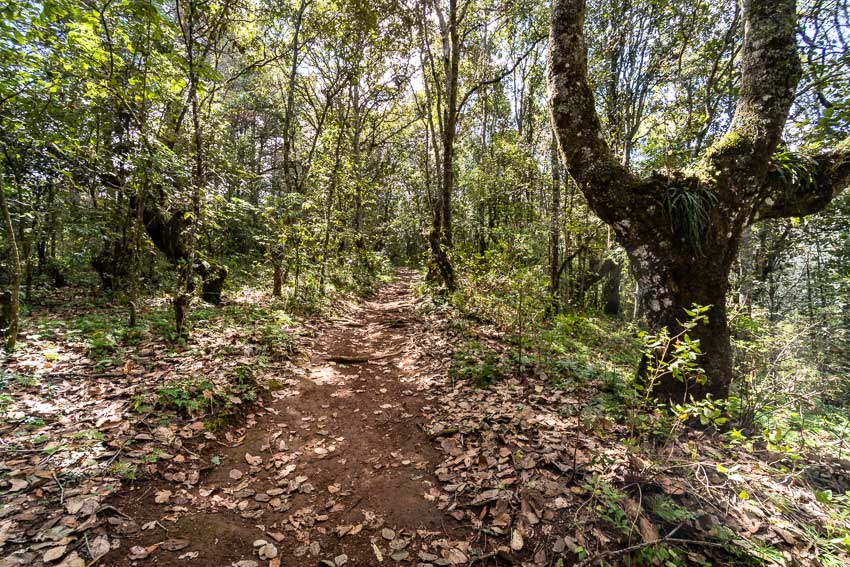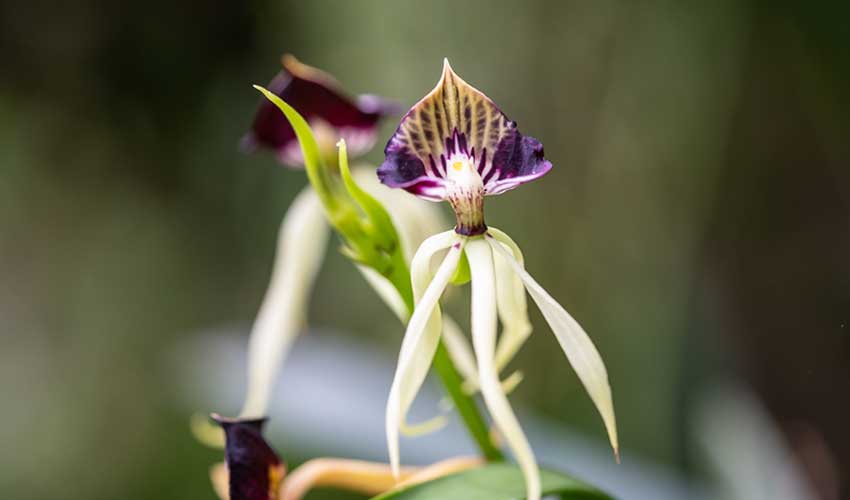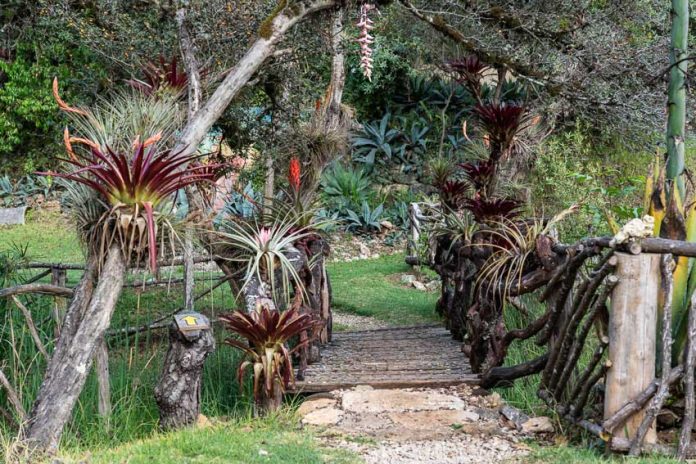Chiapas. Just the name alone conjures up visions of the cascading waterfalls of Agua Azul, the bright blue lakes of Lagos de Montebello, and lush green canopies of the Lacandon Jungle.
The diversity of natural landscapes is unmatched in Mexico, and visitors travel from all over the world to visit the state’s unique ecosystems.
However, you don’t need to go far from San Cristóbal de las Casas to get in touch with nature. A visit to Reserva Huitepec, Orquídeas Moxviquil Botanical Garden and Arcotete Ecotourism Park will be sure to satisfy most nature lovers visiting this colonial city.
Cerro Huitepec stands as the highest peak of all the mountains surrounding San Cristóbal. When visible through the fog and clouds, the mountain is identifiable by the numerous radio towers protruding from its summit. Reserva Huitepec was the first private reserve in Mexico when it was founded by the environmental organization Pronatura Sur in 1986, protecting the rare plants, wildlife and ecosystem that makes up the dormant volcano.
The entrance to Reserva Huitepec is located a short colectivo ride northwest of San Cristóbal, on the highway to San Juan Chamula. After paying the 30 pesos entrance fee, follow the well-built path as it winds steeply up the hillside, through forests of oak and pine trees. Slowly the sounds of the city fade away, replaced by the chirping of some of the 84 species of birds that call the reserve home.

If you’re lucky, you may catch a glimpse of hummingbirds, owls and warblers as they fly through the forest canopy. Don’t forget to keep your eye on the ground as well, where you’ll find over 300 species of plants, including many rare and endangered varieties. Numerous signposts along the way provide more information on the plants in the park, including the species used as medicinal herbs by the local Tzotzil population.
Along the 2.5-kilometer trail there are four rest points, consisting of small shelters, benches and informative signposts. Behind the fourth rest stop, a faint trail takes visitors into the upper reaches of the cloud forest, and beyond to the summit of the mountain.
If your legs don’t feel like carrying you any farther up the hill, take the main trail back to the highway. In total, the path takes 45 minutes to 1.5 hours to complete, depending on the pace. If you enjoyed the plants and flowers of Reserva Huitepec, then Orquídeas Moxviquil Botanical Garden should be next on your list of places to visit.
In the north of the city, Orquídeas Moxviquil occupies two hectares of land on Pronatura Sur’s Reserva Moxviquil. Founded in 2007, the garden was established to house the growing collection of orchids that Craig Dietz, one of the founders of Orquídeas Moxviquil, has rescued since 1994 from areas of deforestation and destruction around Chiapas.
Of the 700 different species of orchids in the state, over 400 have found a new home in the garden, which currently has two greenhouses, an amphitheatre, numerous walking paths and a manmade lagoon that provides water for the flowers.
After paying the 50-peso entrance fee (for non-Mexicans), follow the path to the left where you will reach the first greenhouse. As you enter, the heat and humidity instantly hit you in the face, and in a moment you are transported to the lower elevation jungles of Chiapas.

A short path guides visitors through the chaos of trees, branches and shrubs. But look carefully and you’ll find many species of orchids. Most orchids in the wild reside on trees, at a height between five and 30 meters above the ground, making them out of sight for most.
At Orquídeas Moxviquil, the staff have brought the orchids down to eye level and below, so visitors can see, touch and smell them.
Once finished in the first greenhouse, continue along the path past the lagoon. Fed by rainwater and water pumped from a natural spring, the pond provides the water needed to irrigate the grounds of the garden. It is also populated with popoyote, a species of killifish native to the San Cristóbal valley that is at risk of extinction due to habitat destruction and contamination in nearby waterways.
The second greenhouse contains species of orchids and plants that are found in the Lagos de Montebello region of Chiapas, one of the most endangered ecosystems in the state. The manmade lagoon extends into the greenhouse, giving it a wetlands feel. Benches inside allow you to sit and relax in the surroundings.
Along with the gardens, the grounds also have a two-kilometer hiking trail, taking you farther up into the Reserva Moxviquil and past a greater variety of plants and trees. The exploration of the gardens and the hike can be done either alone or in the company of a guide.
For the more adventure minded, take a visit to Parque Ecoturistico El Arcotete, located east of San Cristóbal de las Casas. The name Arcotete is believed to be an amalgamation of the word arco and the surname of the French explorer, Francois d’Arcecete.

Legend has it that d’Arcecete fell in love with a woman named María de Jesús, and at this location under the arch above the Fogótico river, they swore their unending love to each other. Following a duel in which d’Arcecete took the life of a young Spaniard who also loved María de Jesús, d’Arcecete was sent to prison and María de Jesús banished by her father to a convent, where she died of sadness.
Upon d’Arcecete’s release from prison, he discovered that his love had passed away. Unable to take the grief, d’Arcecete returned to the arch and in true Romeo and Juliet fashion, took his own life.
Today that arch is the main attraction of Arcotete. Formed by the erosion of the Fogótico river running through a cave over millions of years, the arch now hosts an array of rock features, including various stalactites and stalagmites. A cave system runs through the arch, allowing you to view the inside of the arch from 40 meters in the air. Alternatively, head down to the water and relax on a small beach by the river while gazing up to the roof of the cave
For the more courageous, hire a guide from La Roca Sala de Escalada in San Cristóbal and climb the steep limestone cliffs adjacent to the cave. Stronger climbers can impress the onlookers watching from the arch by climbing up its side, across the roof and into the balcony on the cave.
If rock climbing is out of your comfort zone, try rappelling, or zip through the forest above the river on one of the zip-lines that stretch over the property. Finish off your day of adventure with a barbecue in a palapa, or spend the night camping under the stars.
Natural beauty abounds in Chiapas, but you don’t need to look far beyond San Cristóbal de las Casas to find it. Whether it’s the hiking in Reserva Huitepec, visiting the gardens of Orquídeas Moxviquil, or finding adventure in Arcotete, there’s plenty to discover in the immediate surroundings of the town.
